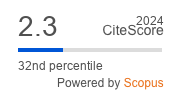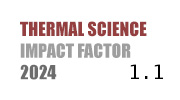THERMAL SCIENCE
International Scientific Journal
Thermal Science - Online First
online first only
Determination of thermal conductivity coefficient of a biocomposite based on wood sawdust
ABSTRACT
Climate changes are altering patterns of energy supply and demand, which directly impact the need for adequate building insulation. This presents an opportunity for the development of new biomass-based materials as a renewable source aimed at reducing energy consumption and protecting the environment. The goal of this research is the application of wood sawdust, a waste biomass, as an aggregate for producing a new thermal insulation material. This experimental investigation represents an opportunity for the development of new biomass-based materials with the aim of reducing energy consumption and improving environmental protection. The biocomposite was tested in terms of thermal conductivity, and the obtained results were compared with the characteristics of commercially available thermal insulation materials. The performed analysis suggested that sawdust can be transformed into a valuable biocomposite for insulation purposes as an alternative solution.
KEYWORDS
PAPER SUBMITTED: 2025-04-12
PAPER REVISED: 2025-06-09
PAPER ACCEPTED: 2025-06-16
PUBLISHED ONLINE: 2025-08-02
- Martinov, M. et al., Study of the spatial distribution of dedicated public storages of agricultural biomass on the territory of AP Vojvodina ("Studija prostornog razmeštaja namenskih javnih skladišta agrarne biomase na teritoriji AP Vojvodinе"), 2016, www.psegs.vojvodina.gov.rs/wp-content/uploads/2013/03/Javna_skladista_agrarne_biomase.pdf
- Bojković, J. et al., Thermal and Sound Characterization of a New Biocomposite Material, Materials, vol. 16, no. 12, p. 4209, Jun. 2023, doi: 10.3390/ma16124209
- Olaiya, B.C. et al., Utilization of sawdust composites in construction—a review, May 01, 2023, Springer Nature. doi: 10.1007/s42452-023-05361-4
- J. A. Ferriz-Papi, Use of sawdust and wood ashes for cement substitution in mortars and concrete, 2015, doi: 10.13140/RG.2.1.5056.4322
- A. Mwango and C. Kambole, Engineering Characteristics and Potential Increased Utilisation of Sawdust Composites in Construction—A Review, Journal of Building Construction and Planning Research, vol. 07, no. 03, pp. 59-88, 2019, doi: 10.4236/jbcpr.2019.73005
- S. Zou et al., Experimental research on an innovative sawdust biomass-based insulation material for buildings, J Clean Prod, vol. 260, p. 121029, Jul. 2020, doi: 10.1016/J.JCLEPRO.2020.121029
- I. Cetiner and A. D. Shea, Wood waste as an alternative thermal insulation for buildings, Energy Build, vol. 168, pp. 374-384, Jun. 2018, doi: 10.1016/J.ENBUILD.2018.03.019
- Tashana Danne Gamiao C. M. et al., Sawdust as an Alternative Resource Material in Producing Wooden Ceiling Panels for Thermal Insulation, 5th DLSU Senior High School Research Congress, 2023, Philippines
- Stasiak M. et al., Mechanical properties of sawdust and woodchips, Fuel, vol. 159, pp. 900-908, Aug. 2015, doi: 10.1016/j.fuel.2015.07.044
- Meez E. et al., Sawdust for the removal of heavy metals from water: Α review, Jul. 02, 2021, MDPI AG. doi: 10.3390/molecules26144318
- Chikri R. et al., Efficiency of sawdust as low-cost adsorbent for dyes removal, 2020, Hindawi Limited. doi: 10.1155/2020/8813420
- Shukla S. S. et al., Removal of nickel from aqueous solutions by sawdust, J Hazard Mater, vol. 121, no. 1-3, pp. 243-246, May 2005, doi: 10.1016/j.jhazmat.2004.11.025
- Rominiyi O. L. et al., Potential Utilization of Sawdust in Energy, Manufacturing and Agricultural Industry; Waste to Wealth, World Journal of Engineering and Technology, vol. 05, no. 03, pp. 526-539, 2017, doi: 10.4236/wjet.2017.53045
- EN 12667:2001 - Thermal performance of building materials and products - Determination of thermal, Feb. 01, 2023., standards.iteh.ai/catalog/standards/cen/f845e9a0-09c4-43ef-955c-6478a0497fb4/en-12667-2001
- ASTM C518-17 - Standard Test Method for Steady-State Thermal Transmission Properties by Means of the Heat Flow Meter Apparatus, Feb. 01, 2023., webstore.ansi.org/standards/astm/astmc51817
- ASTM E1530-06, Standard Test Method for Evaluating the Resistance to Thermal Transmission of Materials by Guarded Heat Flow Meter Technique. - References - Scientific Research Publishing, Feb. 01, 2023., www.scirp.org/(S(351jmbntvnsjt1aadkposzje))/reference/ReferencesPapers.aspx?ReferenceID=2024900
- Rulebook on Energy Efficiency of Buildings (Sl. glasnik RS, Pravilnik o energetskoj efikasnosti zgrada), vol. 61. 2011., www.mgsi.gov.rs/lat/dokumenti/pravilnik-o-energetskojefikasnosti-zgrada (accessed on 10 April 2023).; 148. BSI Standards Publication Thermal Insulating Products for Building Applications-Determination of Water Vapour Transmission Properties; 2013; ISBN 9780580780455

